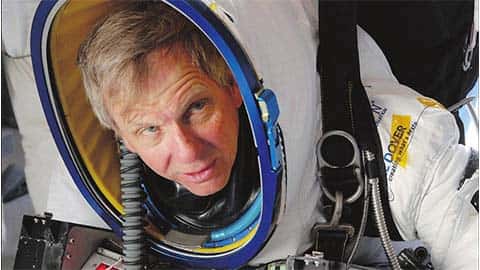Google Exec Leaps from the Edge of Space
We all know Google, but have you heard of Alan Eustace? This former Google executive didn’t just dominate the tech world – he took his ambition to dizzying heights, literally. We’re talking about a record-breaking plunge from the edge of space!
Eustace, with his deep-seated love for science and exploration, teamed up with Paragon Space Development Corporation to launch the StratEx project. Their mission? To push the limits of high-altitude parachute technology and unlock the secrets of the stratosphere.
On October 24, 2014, Eustace, geared up in a custom-designed spacesuit, stepped out of a balloon hovering a mind-blowing 135,890 feet above Roswell, New Mexico. That’s four times higher than commercial airliners fly! For the next 4 minutes and 27 seconds, he plummeted towards Earth at supersonic speeds, breaking the sound barrier and reaching a mind-blowing 822 mph.
This wasn’t just a joyride; it was a scientific mission. Sensors embedded in his suit diligently recorded data on atmospheric conditions, offering precious insights into the mysteries of Earth’s upper atmosphere.
While not as widely publicized as Felix Baumgartner’s jump, Eustace’s achievement continues to inspire the next generation of explorers and dreamers. His journey is a testament to the power of human curiosity, our drive to push boundaries, and the magic that happens when science meets sheer audacity.
How Long Was Alan Eustace’s Free Fall?
After ascending to a breathtaking 135,890 feet, Alan Eustace embarked on a free fall that would last a mind-blowing 4 minutes and 27 seconds. This wasn’t just a daredevil stunt; Eustace’s jump, part of the StratEx project, had a bigger purpose. He and his team at Paragon Space Development Corporation aimed to push the limits of high-altitude parachuting and learn more about the enigmatic stratosphere.
During his descent on October 24, 2014, Eustace didn’t just break the sound barrier—he shattered it, hitting speeds over 822 mph! Not only did he set a new record for the longest free fall, surpassing Felix Baumgartner, but he also provided scientists with invaluable data about the atmosphere.
Here’s a quick recap of Eustace’s amazing feat:
| Feature | Details |
|---|---|
| Free fall duration | 4 minutes and 27 seconds |
| Distance covered | 123,414 feet (more than twice the height of Mount Everest!) |
| Top Speed | 822 mph |
Eustace’s jump wasn’t just about breaking records; it was about pushing the boundaries of human exploration and our understanding of the world above us. It begs the question, what other incredible feats await us in the future of space exploration?
What Was the Altitude of Alan Eustace’s Record-Breaking Jump?
On October 24, 2014, Alan Eustace, a former Google executive, took a leap of faith from a staggering 135,890 feet, a height surpassing the cruising altitude of most airplanes.
To reach this altitude, he rode a massive helium balloon to the edge of space, wearing a specially designed spacesuit. Then, with meticulous planning and a team of experts, he took the plunge. As he fell back to Earth, Eustace reached an incredible 822 miles per hour, exceeding the speed of sound.
His freefall, lasting a breathtaking 4 minutes and 27 seconds, covered over 23 miles – a distance comparable to falling from the summit of Mount Everest and then some! For safety, his descent was managed first by a smaller drogue parachute and then by his main parachute, ensuring a safe return to solid ground.
This incredible feat provided valuable insights into the conditions of the stratosphere. Research like this could help us understand our planet better and potentially unlock further exploration opportunities in the future.
“Alan Eustace broke the record for the longest free fall in 2014, but he says he’s no daredevil, this was pure engineering at work.” – Atomic Entertainment
Eustace’s jump was a testament to the power of engineering, human ingenuity, and the potential for extraordinary achievement.
What is the Highest Skydive in History?
The title of “highest skydive in history” belongs to Alan Eustace, who, in 2014, jumped from a mind-blowing 135,890 feet – over 25 miles above the Earth. To put this into perspective, commercial airplanes typically cruise at around 7 miles high.
Eustace’s leap was a carefully planned endeavor, backed by a team of experts and a significant amount of scientific research. His custom-designed spacesuit, similar to those worn by astronauts, and a massive helium balloon, were crucial to the mission’s success.
Stepping off the balloon platform into the near-vacuum of the stratosphere, Eustace plummeted towards Earth at speeds exceeding 820 mph, surpassing the speed of a fighter jet. His freefall, lasting a nail-biting four minutes and 27 seconds, culminated in the successful deployment of his parachute, bringing him safely back to Earth.
Eustace’s jump wasn’t just about breaking records; it was a testament to human ingenuity and pushing the boundaries of human potential. The technologies developed for this endeavor have paved the way for future adventurers and scientists to explore new frontiers.
What Drove Alan Eustace to Leap From the Stratosphere?
Alan Eustace didn’t jump from the stratosphere in 2014 just to break records. His mission was far more ambitious: he wanted to revolutionize high-altitude travel.
Eustace’s true passion lay in developing groundbreaking technology. He dedicated years to creating a special wearable system that would enable humans to explore the stratosphere safely. His vision extended beyond personal achievement; he sought to democratize access to space, making it possible for scientists, explorers, and even everyday people to experience the edge of space.
His jump, a significant step towards realizing this vision, highlighted the potential for wearable technology to transform high-altitude exploration, making it more accessible and affordable.
If you are curious about other intriguing figures, find out Al Capone’s height or delve into the story of Andre Rison and Lisa Lopes’ funeral.











